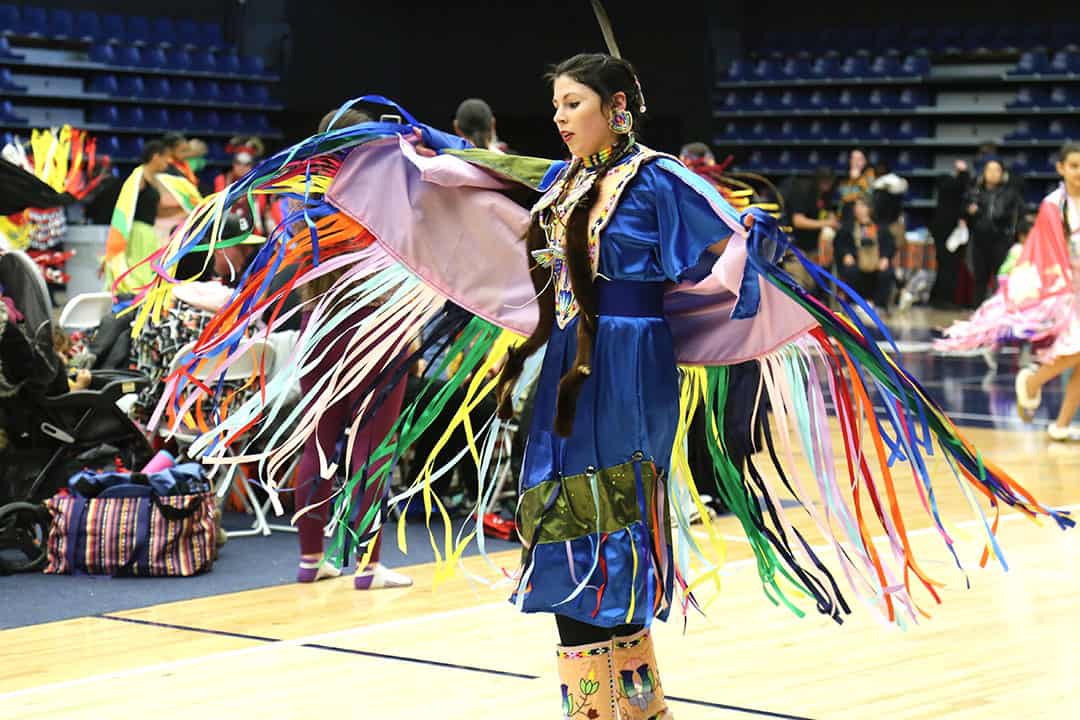The Indigenous Studies Students’ Union (ISSU) held its third annual Pow Wow at the Goldring Centre for High Performance Sport on March 16. It was a stunning celebration of Indigenous cultures. The event was brought back in 2017 after a 20-year hiatus and featured food, vendors, and traditional dances that attendees were encouraged to join.
The event started with a Grand Entry, in which participants carried flags representing the First Nations, Inuit, and Métis people, as well as the flags of Canada, the United States, and U of T. This was followed by a march for military veterans, which any attending veterans were encouraged to participate in.
In an interview with The Varsity, fourth-year Indigenous Studies and Equity Studies student Chantell Jackson emphasized the importance of these celebratory events. “Every year it needs to be done because it just brings knowledge of Indigenous culture and community to a place like U of T, where you don’t often see a lot of diversity,” Jackson said. “It definitely draws on the positive parts of Indigenous culture and community, and I think that’s what not only U of T students but the community as a whole need to learn.”
Master of Ceremonies Bob Goulais stopped on two separate occasions to acknowledge the tragedy that occured in Christchurch, New Zealand on March 15, when 50 people were killed in shootings at two separate mosques in an apparent act of white supremacist terrorism. Goulais said that the Indigenous community stands in solidarity with the Muslim community during this time of mourning.
Participating in Pow Wows is not something that Indigenous people were always able to do because of Canada’s settler-colonial system. In 1876, the Indian Act restricted participation in traditional Indigenous ceremonies and prevented Indigenous people from wearing traditional regalia.
In 1921, Indian Affairs Minister Duncan Campbell Scott banned dancing on reserves, and Pow Wows only gained resurgence in North America starting in the 1960s with Indigenous rights movements.
“It’s really important that we’re doing this, and covering all this music and dance,” Head Male Dancer and U of T professor Amos Key Jr. told The Varsity. “A lot of it just went underground; we didn’t do it publicly. That’s why I think it’s really important for us.”
“It’s healthy to move. It’s healthy for your heart and for your love of the heart; it’s all good,” Key told The Varsity. “I can’t imagine our people 100 years ago when we were dancing every night. That’s why they outlawed it, because the colonizers didn’t realize how important it was for health.”
The recent Indian Day School settlement was brought up toward the end of the event to recognize Indigenous victories. In this settlement from the federal government, survivors of federally-run schools, many of which were established in northern Canada, received up to $200,000 as reparation for the abuse and neglect they experienced.
Many of the attendees stressed the importance of these types of events in bringing awareness to Indigenous issues and bridging the gap between Indigenous and non-Indigenous students.
“I think these events are important because it shows that U of T cares about Indigenous students, and it shows Indigenous peoples that they can be a student here,” Head Female Dancer Myopin Cheechoo said in an interview with The Varsity.
ISSU Membership Support Coordinator Ziigwen Mixemong spoke to The Varsity about the value that Indigenous celebrations have to her and the community as a whole.
“To me, it’s just a place that I can really unapologetically [be] Indigenous at an institution such as U of T. A hundred years ago, I wouldn’t have been able to even walk on this campus, let alone be in full regalia and be at a Pow Wow… Being able to even just dance in it, even just organize it, is a tremendous honour that I have,” Mixemong said.
“I often think that people who come from mainstream society, who are settlers, often feel this tremendous amount of guilt over what has happened, and I always say that it’s not about the guilt. It’s about the fact that we have inherited this history, and what do we do with it now?”


